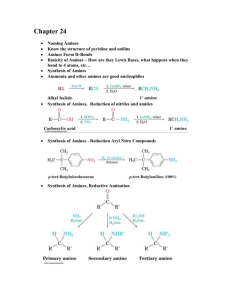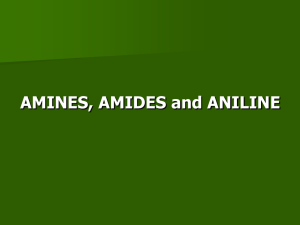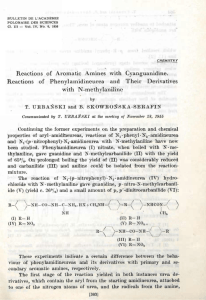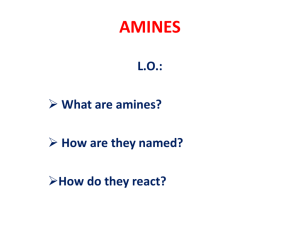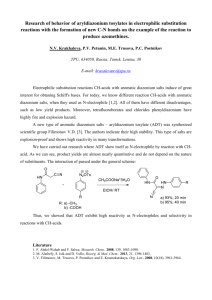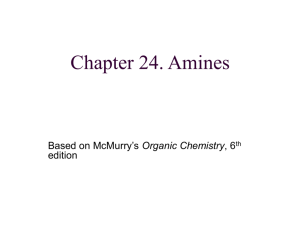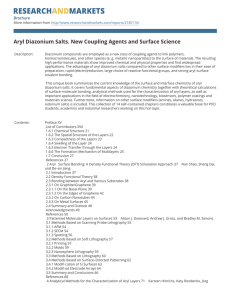AMINES 1
advertisement
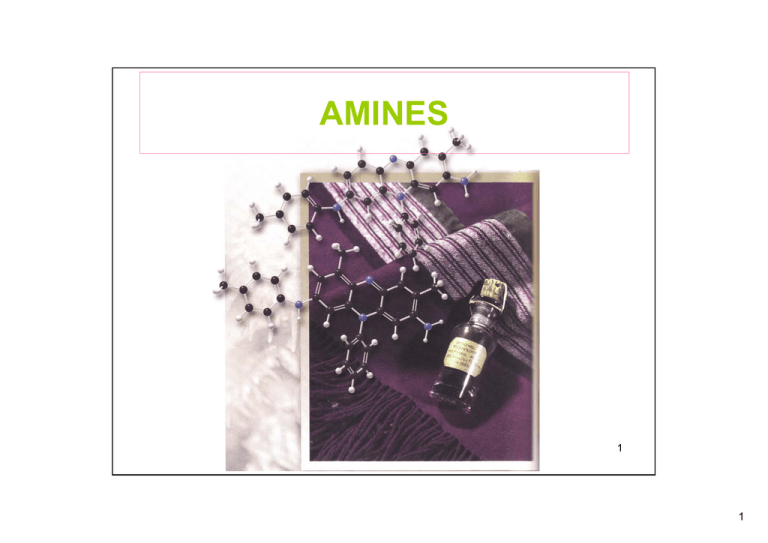
AMINES 1 1 AMINES Amines are organic nitrogen compounds, formed by replacing one or more hydrogen atoms of ammonia (NH3) with alkyi groups. the amine nitrogen atom has a nonbonded electron pair, making it both a base and a nucleophile. As a result, amines react with electrophiles to form quaternary ammonium salts 2 2 Aromatic Amines Nitrogen Heterocycles 3 3 Simple Amines and Alkaloids 4 4 Preparation of Amines Three types of reactions are used to prepare an amine: [1] Nucleophilic substitution using nitrogen nucleophiles [2] Reduction of other nitrogen-containing functional groups [3] Reductive amination of aldehydes and ketones 5 5 Nucleophilic Substitution Routes to Amines 6 6 Examples 7 7 The Gabriel Synthesis of 1o Amines Avoid polyalkylation, the Gabriel synthesis consists of two steps and uses a nucleophile derived from phthalimide to synthesize 1o amines via nucleophilic substitution. 8 8 Problem 9 9 Reduction of Other Functional Groups that Contain Nitrogen 10 10 Reductive Amination of Aldehydes and Ketones 11 11 12 12 Reactions of Amines Amines react as nucleophiles with electrophilic carbon atoms. Amines attack carbonyl groups to form products of nucleophilic addition or substitution. 1. Reaction of 1o and 2o amines with aldehydes and ketones 13 13 2. Reaction of NH3 and 1o and 2o amines with acid chlorides and anhydrides 14 14 3. Reaction of amines with nitrous acid Nitrous acid, HNO2, is a weak, unstable acid formed from NaNO2 and a strong acid like HCl In the presence of acid, nitrous acid decomposes to +NO, the nitrosonium ion. This electrophile then goes on to react with the nucleophile nitrogen atom of amines to form diazonium salts (RN2+Cl-) from 1o amines and N-nitrosamines (R2NN=O) from 2oamines. 15 15 Formation of a Diazonium Salt from a 1o Amine 16 16 Substitution Reactions of Aryl Diazonium Salts Aryl diazonium salts react with a variety of reagents to form products in which Z (an atom or group of atoms) replaces N2, a very good leaving group. The mechanism of these reactions varies with the identity of Z, so we will concentrate on the products of the reactions, not the mechanisms. 17 17 Substitution Reactions of Aryl Diazonium Salts HBF4 : fluoroboric acid H3PO2: hypophosphorus acid 18 18 Using Diazonium salts in Synthesis 19 19 The Synthesis of 1,3,5-Tribromobenzene from Benzene - Nitration followed by reduction forms aniline (C6H5NH2) from benzene (Steps [1] and [2]). - Bromination of aniline yields the tribromo derivative in Step [3]. - The NH2 group is removed by a two-step process: diazotization with NaNO2 and HCI (Step [4]), followed by substitution of the diazonium ion by H with H3PO2. 20 20 Quiz Solution 21 21 Coupling Reactions of Aryl Diazonium Salts The second general reaction of diazonium salts is coupling. When a diazonium salt is treated with an aromatic compound that contains a strong electron-donor group, the two ring join together to form an azo compound, a compound with a nitrogen-nitrogen double bond. Example 22 22 Mechanism azo coupling Because a diazonium salt is only weakly electrophilic, the reaction occurs only when the benzene ring has a strong electron-donor group Y, where Y = NH2, NHR, NR2, or OH. Although these groups activate both the ortho and para positions, para substitution occurs unless the para position already has another substituent present. 23 23 Quiz 24 24 Solution 25 25 Natural Dyes 26 26
